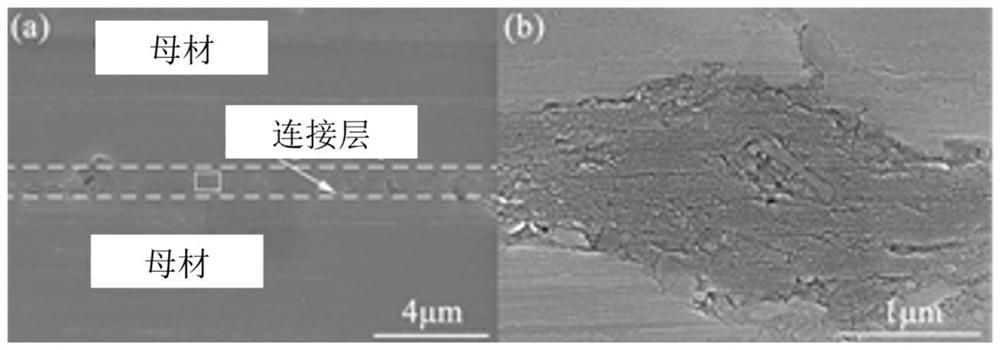Silicon carbide ceramic connection method and silicon carbide cladding
A technology of silicon carbide ceramics and connection methods, which is applied in the field of nuclear energy materials, can solve the problems of reducing joint reliability, pores, and large volume shrinkage, and achieve the effects of reducing pore defects, simple connection process, and improving air tightness
- Summary
- Abstract
- Description
- Claims
- Application Information
AI Technical Summary
Problems solved by technology
Method used
Image
Examples
Embodiment 1
[0049] With molecular formula (-SiHCH 3 -CH 2-) n polycarbosilane as a precursor, n = 17, the ceramic yield is 60wt%; 0.3wt% dicumyl peroxide is used as a curing agent, and the temperature is raised to 120°C at 3°C / min under an argon atmosphere After 2 hours of heat preservation, the temperature was raised to 150°C at 1°C / min for 2 hours, and then cooled with the furnace. The cured precursor was continued to be pretreated under a nitrogen atmosphere at a rate of 5°C / min to 500°C and kept for 2h to prepare a powder. Using absolute ethanol as an organic solvent, mix the above powder and absolute ethanol at a ratio of 25wt%:75wt% to obtain a slurry. After the silicon carbide-slurry-silicon carbide sandwich structure is formed, the above sandwich structure is first placed in an oven at 80°C for 2 hours, then placed in a tube furnace, and heated at 10°C / min to 1500°C for 2 hours. Cracking, cracking is carried out under nitrogen atmosphere. After cleavage, the thickness distribu...
Embodiment 2
[0052] With molecular formula (-SiHCH 3 -CH 2 -) The polycarbosilane of n is used as a precursor, n=10, and the ceramic yield is 70wt%; with 0.5wt% of dicumyl peroxide as a curing agent, with xylene as an organic solvent, after curing and pretreatment The volume ratio of the precursor to the organic solvent is 30wt%: 70wt%; a 100 μm thick slurry layer is coated on the surface of the end plug, and the connection is carried out according to the method in Example 1, wherein the curing temperature is 160 ° C, the pretreatment temperature is 800 ° C, and the cracking The temperature is 1200°C.
[0053] For the SiC ceramic connector prepared in Example 2, the thickness of the connecting layer is 5 μm; the room temperature shear strength of the SiC ceramic connector is 80 MPa, the high temperature shear strength at 1200 °C is 100 MPa, and the airtightness of the joint is 10 -10 Pa·m 3 / s, the corrosion rate of the connecting layer after hydrothermal corrosion is 5% higher than tha...
Embodiment 3
[0055] With molecular formula (-SiHCH 3 -CH 2 -) The polycarbosilane of n is used as a precursor, n=40, and the ceramic yield is 80wt%; with 0.5wt% metal platinum as a curing agent and xylene as an organic solvent, the cured and pretreated precursor and organic The solvent volume ratio is 35wt%: 65wt%; a 50 μm thick slurry layer is coated on the surface of the end plug, and the connection is carried out according to the method in Example 1, wherein the curing temperature is 140°C, the pretreatment temperature is 700°C, and the cracking temperature is 1500°C .
[0056] The thickness of the connecting layer of the SiC ceramic connector prepared in Example 3 is 4 μm; the room temperature shear strength of the SiC ceramic connector is 90 MPa, the high temperature shear strength at 1200 °C is 100 MPa, and the airtightness of the joint is 10 -11 Pa·m 3 / s, the corrosion rate of the connecting layer after hydrothermal corrosion is 2% higher than that of the base metal.
PUM
| Property | Measurement | Unit |
|---|---|---|
| thickness | aaaaa | aaaaa |
| shear strength | aaaaa | aaaaa |
| thickness | aaaaa | aaaaa |
Abstract
Description
Claims
Application Information
 Login to View More
Login to View More - R&D
- Intellectual Property
- Life Sciences
- Materials
- Tech Scout
- Unparalleled Data Quality
- Higher Quality Content
- 60% Fewer Hallucinations
Browse by: Latest US Patents, China's latest patents, Technical Efficacy Thesaurus, Application Domain, Technology Topic, Popular Technical Reports.
© 2025 PatSnap. All rights reserved.Legal|Privacy policy|Modern Slavery Act Transparency Statement|Sitemap|About US| Contact US: help@patsnap.com

